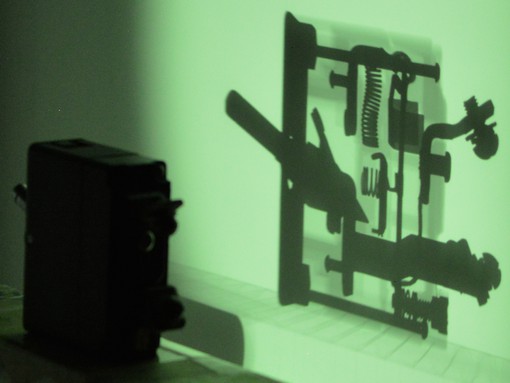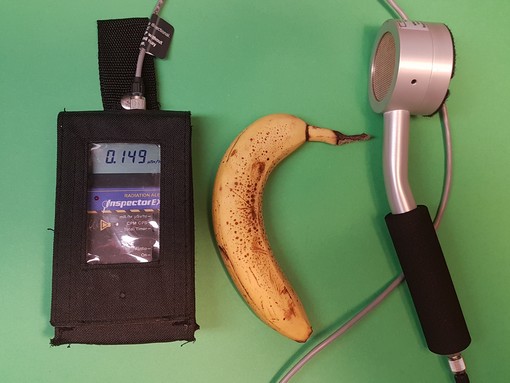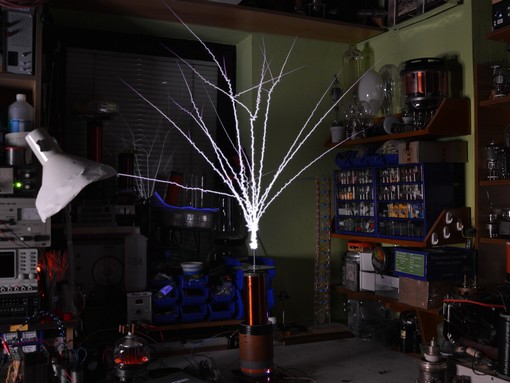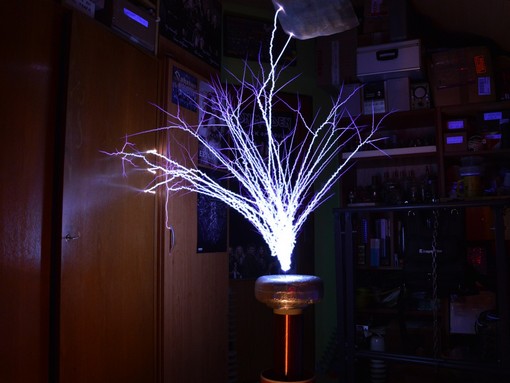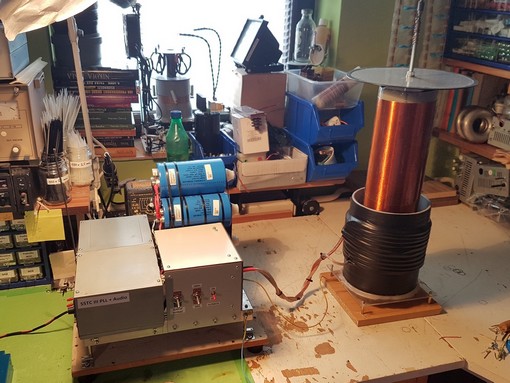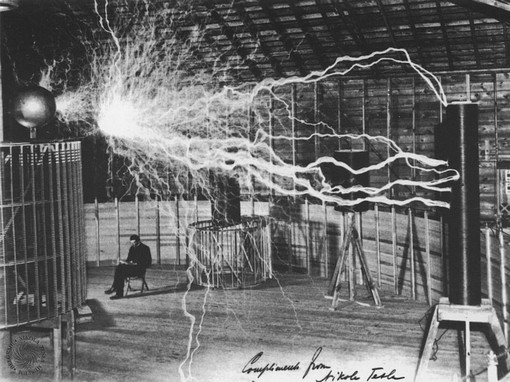It is a simple alpha particle detector of radioactive radiation suitable for demonstration purposes or as a curiosity. The detector uses a high voltage source in units of kV.
It is a simple (spark) detector of alpha particles of radioactive radiation suitable for demonstration purposes or as a curiosity. The detector uses a high-voltage source whose positive voltage of several kV is applied to the upper wires routed over a grounded metal plate. This type of detector is only sensitive to alpha particles, only these can sufficiently ionize the gas at atmospheric pressure to cause a jump in discharge from the positive grid to the grounded metal plate. For beta and gamma rays this detector will not work. To get a better idea in a diffuse cloud chamber, you can see nicely the thickness of the cloud trails after ionization of the gas from the alpha particle and electron. The gap between the wires and the plate is set to the critical distance at the applied voltage (i.e., the limiting distance where the discharge will not yet spontaneously jump).
My construction uses the HV source board at +7.5kV from some unknown Japanese HV source for an unknown device. The HV source is not critical in any way, anything with a small output to units of kV either directly from the HV transformer of the inverter or using a multiplier. Discharges from the wires must be capacitive, not arc ignited. At the same time, the high voltage itself is on the top grid, so the HV source must not be dangerous if the discharge accidentally jumps into the fingers or tweezers. The distance between the wires and the duralumin base is 6.3mm.
Edit: Later I found out that the detector will work even with switched electrode polarities. Thus grounded grid and positive HV at the bottom base. However, this will change the detector property, reducing the jump and critical distance. It will be necessary to reduce the gap between the electrodes. I haven't tested it this way, I use a safe HV source that is not dangerous if a spark jumps into my finger, so I haven't addressed it. It is easier to jump a discharge from a thin positive wire to a flat surface than from a negative wire to a flat surface.
However, the worst part is not the HV source, but the mechanical design of the detector with electrodes. The whole structure has to be geometrically good designed and suitable wires have to be used. The thinner the wires, the better. At the same time, this does't work with any metal. Copper thin wires gave me problems and didn't work with them, some people didn't work with steel thin wires either, for me stainless steel wires from an egg slicer worked well. The stainless steel proved to be a good material and at the same time the whole netting is already finished nicely in plane without any work. According to what I found on the web, thin tungsten wires are ideal for the best effect and functionality. The photos below and the attached video will tell more of the construction itself.
https://www.vn-experimenty.eu/en/radioaktivita/vn-iskrovy-detektor-alfa-castic.html?filter_tag[0]=21#sigProIdefb9f55ae0
Americium (241Am) from fire detectors and autunite uranium minerals were used for the alpha particle source. Suitable americium-241 can also be found here for example in the ionization chamber for the detector on Aliexpress labelled NAP-07.
https://www.vn-experimenty.eu/en/radioaktivita/vn-iskrovy-detektor-alfa-castic.html?filter_tag[0]=21#sigProId02e732887c
Alpha particle HV spark detector 2
I decided to modify the spark detector and redo the top mesh. I bought a thin 0.15mm tungsten wire on eBay. I was looking for something as thin as possible, available and reasonably priced. Outside of eBay, I don't even know where to look for it here in Slovakia. Easiest way if one has time for shipping.
The mechanical construction and manufacturing process can be seen in the photos below, so just briefly. The very basis is strength. When the tungsten wire is stretched, the base for attachment must not sag and must remain firmly in place. The wires must remain flush with no overhang. I used as thick a PCB as possible, double pin rails and tin plated the bottom of the PCB and the wires for added strength. Due to the properties of the tungsten wire, overhang and holding position on the pin rail connectors was not a problem. The problem turned out to be the mechanical attachment of the two ends. I used a feather spring on one end to permanently tension one side. I couldn't use the spring on the other end and the wire broke, so I just wrapped it around the pins when stretching, bent them and tinned them. The wire is fragile to break, on this beware, it's not copper and at that price per length in metres one doesn't really want to break tungsten wire.
The distance between the wires and the duralumin base has been increased from the previous 6.3mm to 6.6mm. After the HV power supply on the grid I have included 2x 1k/3W resistors in parallel for a slight damping of the discharges. The high resistor value on the other hand made more problems, but without the resistor goes unnecessarily high current pulse. You also need to experiment a bit with the resistor value depending on the use of the HV source.
The wire spacing on the stainless steel egg mesh is 5.1mm. I made the tungsten wire mesh with 2.54mm spacing according to the pin bar. Now I also have double the density of the mesh.
The result of the detector is great. The use of tungsten wires slightly but noticeably increased the efficiency of the spark detector. It responds perfectly to americium (241Am) from fire detectors. It also reacts to uranium minerals, but I only tested a smaller piece of pebble with the entire surface of the Autunite. It even reacted to my tungsten thorium cathode from a microwave oven magnetron. The magnetron cathode contains up to 2% thorium impurity. Only the video below of the detector's functionality will tell and show more. But given the higher complexity of the design, a stainless steel egg slicer is still a good and simple alternative.
https://www.vn-experimenty.eu/en/radioaktivita/vn-iskrovy-detektor-alfa-castic.html?filter_tag[0]=21#sigProId432cde6440
Sources of alpha radiation used in the video. From left, autunite uranium mineral, americium-241 from TESLA MHG 103 fire detector and from Aliexpress NAP-07, internal system with tungsten thorium cathode from a microwave oven magnetron with up to 2% thorium content. An overview of the various radioactive items commonly around us can also be found here in the article.
https://www.vn-experimenty.eu/en/radioaktivita/vn-iskrovy-detektor-alfa-castic.html?filter_tag[0]=21#sigProId55efa66a1e





